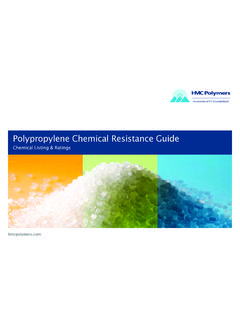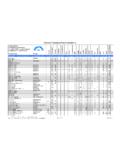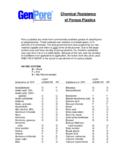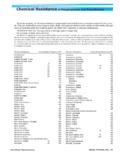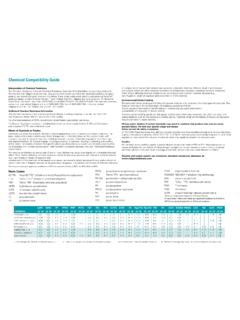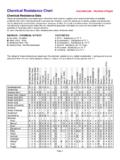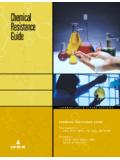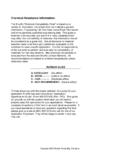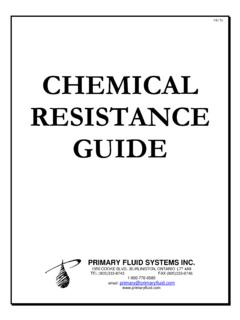Transcription of CHEMICAL RESISTANCE GUIDE - Finemech
1 CHEMICAL RESISTANCE GUIDE CHEMICAL RESISTANCE guideISO 9001:2008 CERTIFIEDPure Chemicals Mixed ChemicalsPVC CPVC PP PVDF PTFE PFAEPDM FPM/FKM (Viton ) Nitrile chemline Plastics Limited 20162 | CHEMICAL RESISTANCE GUIDE CRG 7-16 | RESISTANCE guideISO 9001:2008 CERTIFIEDPure Chemicals Mixed ChemicalsPVC CPVC PP PVDF PTFE PFAEPDM FPM/FKM (Viton ) Nitrile CPEC hemical RESISTANCE GUIDE pageMaterials of Construction 3-6 Pure Chemicals 7-33 Mixed Chemicals 33-34 Materials of ConstructionNote: Properties of plastics and elastomers vary because different compounds of the same material are used for different products and components.
2 The following materials descriptions are of a general nature. chemline should be consulted for material recommendations on specific plastics are made from synthetic resins (polymers) through the process of polymerization. Two main types of plastics are thermoplastics and thermosets. Thermoplastic products are injection moulded or extruded from compound material processed under heat and (Polyvinyl Chloride) The largest selection of chemline valves and controls are moulded in PVC. This rigid gray colour material is unplasticized polyvinyl chloride. PVC is formed by the polymerization of the vinyl chloride monomer.
3 Unplasticized PVC or PVC-U has excellent mechanical and CHEMICAL RESISTANCE properties at low cost. The working temperature range of PVC valves is 0 to 60 C (30 to 140 F). Vinyl is plasticized PVC. The added plasticizer produces a flexibile material for such products as tubing, but offers poor CHEMICAL PVC used for chemline valves is identified by cell classification number 12454-A as per ASTM Standard D 1784. Suffix A refers to the highest CHEMICAL RESISTANCE rating. Most other PVC valves as well as pipe and fittings have only a B CHEMICAL RESISTANCE rating. The special PVC A compound used in chemline valves resists attack of most acids, strong alkalais, salts and many other chemicals.
4 High CHEMICAL RESISTANCE of this material allows its application on aggressive services such as 98% H2 SO4, dry chlorine and low pressure wet chlorine gas. PVC is attacked by chlorinated hydrocarbons, ketones, esters and some aromatic compounds. It can be used on solutions containing up to 1000 ppm PVC valves are non-toxic. They meet CSA standard for toxicity and NSF/ANSI Standard 61 for contact with drinking water. They are resistant to damaging effects of sunlight and weathering, thus painting is not (Chlorinated Polyvinyl Chloride) CPVC is PVC that has been chlorinated via a free radical chlorination reaction.
5 It is similar to PVC in CHEMICAL RESISTANCE . Mechanically it is more ductile than PVC. It s main difference is higher working temperature ratings and is therefore used where temperatures are too high for PVC or when an extra margin of safety is required. Valves are suitable for applications from 0 to 95 C (30 to 200 F).The CPVC compound used for chemline valves is classified as 23567-A as per ASTM D 1784. The suffix A denotes conformance to the highest CHEMICAL RESISTANCE rating. Most other CPVC valves as well as pipe and fittings have only a B CHEMICAL RESISTANCE rating.
6 The compound is non-toxic, conforming to CSA toxicity standard (Pigmented Polypropylene) Polypropylene (PP) is a thermoplastic polyolefin made from the olefin propylene. A more modern term for polyolefin is polyalkene. chemline offers piping systems, valves and controls normally in pigmented PP. The addition of grey-beige pigment prevents degradation due to ultraviolet light is used in a wide variety of applications from acids and alkali s to organic solvents as well as pure water. PP is one of the best materials to use for systems exposed to varying pH levels, as many plastics do not handle both acids and bases well.
7 It is excellent on acids such hydrochloric and phosphoric acid but unsuitable on strong acids like concentrated nitric, also chlorinated hydrocarbons, aromatic compounds and high concentrations of free chlorine. PP is ductile at ambient temperature and has good impact strength. It also has good thermal stability up to 90 C (194 F) , higher than that of other thermoplastics such as PVC and HDPE. It is light weight. The specific gravity is compared to for PVC. It s abrasion RESISTANCE is good, much better than that of PVC. This is a feature of chemline PVC butterfly valves which have PP discs as PP pipe and fittings weld together very well using either butt or socket fusion.
8 The pressure losses in PP piping systems are lower than metal because of the smooth inside surfaces of the pipes. This property also minimizes or eliminates deposits or bacterial growth. PP is a poor conductor of heat, is a good insulator. Chilled or hot water systems in PP often require no is very inert and relatively inexpensive, thus popular for high purity water systems. The standard pigmented material is normally used. Special grades include U-PP (unpigmented, natural) translucent material sometimes preferred for pure water systems, pigmented black for the highest RESISTANCE to UV light, flame retardant grades to meet building code requirements, and electro-conductive grades for volatile is available in two grades: Homopolymer (PP-H) made from Type I resin conforming to ASTM D 4101, produced from 100% propylene monomer.
9 PP-H is the most widely utilized. It offers a high strength to weight ratio and is stiffer and stronger than the copolymer grade. Piping is normally PP-H. a few chemline valves are also PP-H. The working temperature range of PP-H back pressure valves for example is 10 to 70 C (50 to 158 F). Random Copolymer (PP-R) made from Type II resin produced from 94% propylene with 6% ethylene. PP-R is a bit softer but has better impact strength, is tougher and more durable than PP-H. Copolymer polypropylene has better stress crack RESISTANCE and low temperature toughness than homopolymer at the expense of small reductions in other properties.
10 Most chemline valves and all the pipe fittings are PP-R. PP-R pipe is also available. The working temperature range of chemline s PP-R ball valves is 20 to 80 C ( 4 to 176 F) and up to 90 C (194 F) for diaphragm valves. U-PP (Unpigmented Polypropylene) U-PP is produced from high-purity virgin random copolymer. chemline offers PP pipe, fittings and valves in unpigmented PP. U-PP shows excellent purity levels when tested in standard static leach tests (better than high-purity PVC) and has a superior surface quality, smoothness (Ra= to m), making it a popular choice for high-purity water systems.
